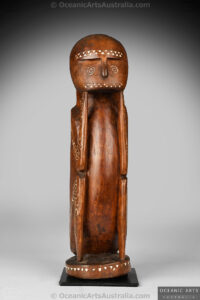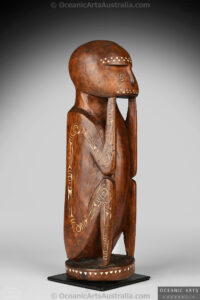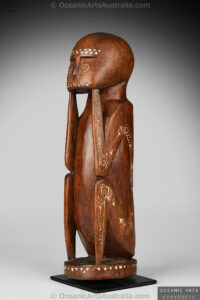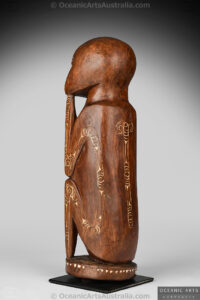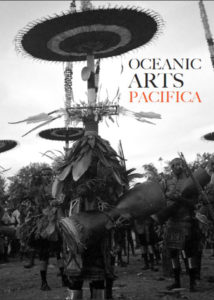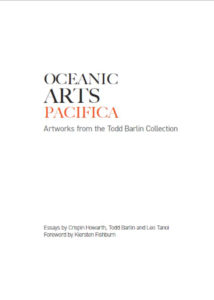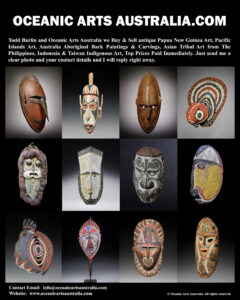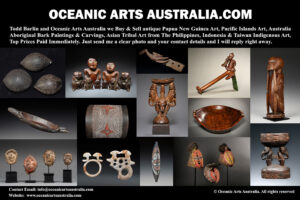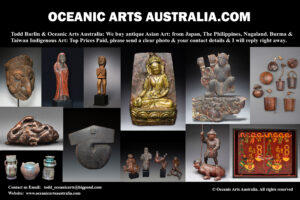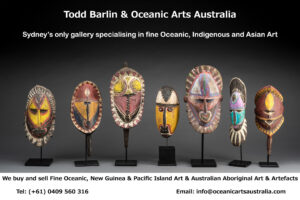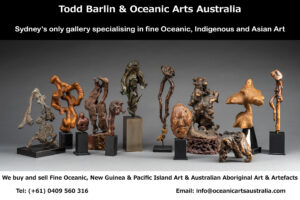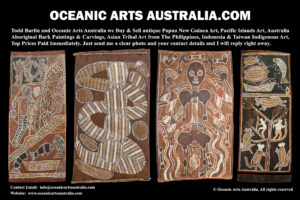A Fine Old New Guinea Massim Ancestor Figure from Milne Bay Province Eastern Papua New Guinea
| Collection No. | TB-3882 |
|---|---|
| Size | Height 47cm |
A Fine Old Massim Ancestor Figure from Milne Bay Province Eastern Papua New Guinea This figure dates from the early 20th Century
This fine old and large Massim Squatting Ancestor Figure is from the Milne Bay Province in Eastern Papua New Guinea. Finely carved in a naturalistic style sitting with the elbows resting on the knees & the hands held under the chin, carved from a single piece of hardwood, and the incised designs and facial features are highlighted with white lime.
Culturally the Milne Bay region is referred to as “the Massim,” a term originating from the name of Misima Island but is used to describe the artworks from the whole province made of 600 islands, about 160 of which are inhabited.
The squatting figure is a style of figure that runs from all the way from the indigenous people of Taiwan through SE Asia; Indonesia & the Philippines and throughout the Island of New Guinea.
The Massim are well known for other types of beautiful artworks like their intricately carved canoe ornaments and fantastically imaginative Lime Spatulas. The Massim are also known for their great maritime skills and a complex trading system called the Kula Ring. Kula is also the name for certain ornaments & wealth objects like stone axe blades and shell money. These valuables are traded purely for the purpose of enhancing one’s social status and prestige.
Carefully prescribed customs and traditions surround the ceremonies that accompany the exchanges which establish strong, ideally lifelong relationships between the exchange parties (karayta’u, “partners”). The act of giving is a display of the greatness of the giver, accompanied by shows of exaggerated modesty in which the value of what is given is actively played down. Such a partnership involves strong mutual obligations such as hospitality, protection, and assistance. Kula valuables never remain for long in the hands of the recipients; rather, they must be passed on to other partners within a certain amount of time, thus constantly circling around the ring. However, even temporary possession brings prestige and status. Important chiefs can have hundreds of partners while less significant participants may only have fewer than a dozen.
Provenance: Old Collection Australia and The Todd Barlin Collection of New Guinea Oceanic Art
See all of the links & photos in my new EXHIBITIONS GALLERY showing the Museums & Art Gallery Exhibitions that I provided artworks for over the past 40 years. There is the link to the article about my artworks published in the prestigious Louvre Magazine in 1996
I have artwork for Museums and art Galleries but also for collectors at every stage of their collecting. I want to encourage people to explore the fine art of New Guinea & West Papua and the Pacific Islands and to be able to see and touch the artworks in a relaxed and friendly manner in my Sydney Gallery. I would like to invite you to visit my gallery and see the artworks in person and also look at my website www.oceanicartsaustralia.com where there are many Galleries & Sub Galleries to explore.
My Gallery of nearly 40 years is the last physical gallery in Sydney that specializes in New Guinea and Oceanic Art. Sydney is very close to New Guinea & the Pacific Islands where all of these amazing artworks came from, Australia’s closest neighbors.
INQUIRE HERE
To see many more rare items and the finest masterpieces, please make an appointment with us to visit the gallery.
For all inquiries, please contact us

